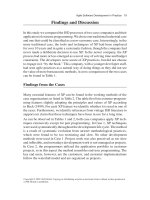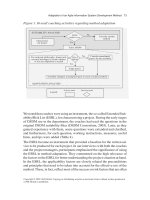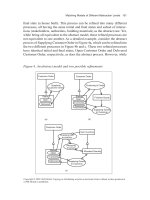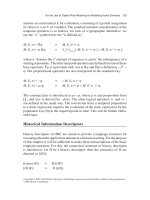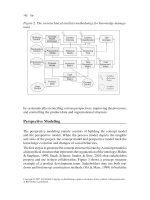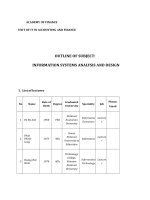Systems analysis and development CIS210 ch 09
Bạn đang xem bản rút gọn của tài liệu. Xem và tải ngay bản đầy đủ của tài liệu tại đây (74.37 KB, 12 trang )
CIS 210
Systems Analysis
and Development
Week 6 Part I
Structuring Systems
Data Requirements
Objectives
• Upon completion of part I you will be able to:
– Understand and be able to explain the concepts related to data
modeling terms
– Understand and be able to draw entity relationship diagrams
– Understand and be able to explain the concepts related to
conceptual data modeling
– Understand and be able to explain the concepts related to
distinguish between unary, binary, and ternary relationships
– Understand and be able to explain the concepts related to
defining rules for business use in E-R diagrams
Overview
• Data Modeling: Why is it Important?
– Characteristics of data are crucial
– Data are most complex aspects of information
systems
– Data characteristics reasonably permanent
• E-R Diagramming / Class Diagramming
– Explain structure of data
– Mastery is crucial to success
Conceptual Data
Modeling
• What is a Conceptual Data Model
– Representation of organizational data
– Rules and meaning of data
• Conceptual Data Modeling Process
– Develop model for existing system
– Develop model for new system
– Encapsulates all SDLC phases
• Deliverables
– E-R diagram
– Entries in data dictionary
Gathering
Information
• Top-Down Approach
– Understanding of the nature of the business
– No specific information requirements
• Bottom-Up Approach
– Specific business documents
• Computer displays
• Reports
• Business forms
Introduction to
E-R Modeling
• Overview
– E-R model
– E-R Diagram
• Entities
–
–
–
–
Entity type
Entity instance
Naming and defining types
Attributes
• Naming and defining attributes
• Multi-valued attributes
– Candidate keys and identifiers
• Relationships
– Associations
Conceptual Data
Modeling and the ER Model
• Degree of Relationship
– Unary
– Binary
– Ternary
• Cardinalities in Relationships
– Minimum
– Maximum
• Naming and Defining Relationships
– Naming guidelines
– Guidelines for defining
• Associative Entities
Representing
Supertypes & Subtypes
• Subtype
– Sub grouping of entities
• Supertype
– Generic entity type
• Relationship Rules
–
–
–
–
Total specialization
Partial specialization
Disjoint rule
Overlap rule
Business Rules
• Types of Business Rules
– Entity integrity
– Referential integrity constraints
– Domains
• Domain definitions
– Triggering operations
• Components
–
–
–
–
–
User rule
Event
Entity name
Condition
Action
Packaged Conceptual
Data Models
• Overview
– Comparatively low cost
– Generic data models
– Developed by specialists
• Types of Packaged Data Models
– Universal
– Industry specific
• Benefits
– Time
– Cost
– Quality
Object Modeling
•
Representing Objects and Classes
–
–
–
–
–
–
•
Types of operations
–
–
–
–
•
Object
State
Behavior
Object class
Class diagram
Operation
Constructor
Query
Update
Scope
Representing
–
–
–
–
Associations
Association Classes
Derived Attributes, Associations, and Roles
Generalization
Summary
•
•
•
•
•
•
•
Conceptual Data Modeling
Gathering Information
E-R Modeling
Supertypes and Subtypes
Business Rules
The Role of Packaged Conceptual Data Models
Object Modeling


